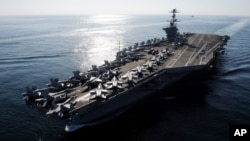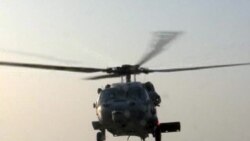The United States and more than 30 other countries have conducted the largest ever minesweeping exercise in the Persian Gulf -- where Iran is threatening to block the strategic Strait of Hormuz. The moves come as the U.S. and Israel are again warning that force could be used to stop Tehran from developing a nuclear weapons capability.
The multinational operation, led by the United States in the Gulf, was a very public notice to Iran, which has threatened to mine these waters, the corridor for a fifth of the world’s oil.
At the same time, Israel held its largest military drill in years as tension with Iran over its controversial nuclear program continues to rise.
Israeli officials say Iran is just months away from a nuclear-weapons capability.
"Shockingly some people have begun to peddle the absurd notion that a nuclear-armed Iran would actually stabilize the Middle East. Yea right," Israeli Prime Minister Benjamin Netanyahu said. "That is like saying a nuclear-armed al-Qaida would usher in an era of universal peace."
World powers suspect Iran is seeking to develop nuclear weapons, although Tehran insists it wants nuclear technology for peaceful means.
“Fundamentally we do not take seriously the threats of the Zionists vis-à-vis an attack on Iran by them," Iranian President Mahmoud Ahmadinejad said during his speech before the U.N. General Assembly. "Even though Iran, at the end of the day, is a great country and let me assure you we do have all defensive means at our disposal and we are ready to defend ourselves.”
The U.S. is moving significant firepower to the Persian Gulf and is increasing the number of fighter planes that could strike deep into Iran. President Barack Obama says he favors diplomacy, but has not ruled out a military option.
“Make no mistake: a nuclear-armed Iran is not a challenge that can be contained. It would threaten the elimination of Israel, the security of Gulf nations and the stability of the global economy,” Obama said.
Sanctions on Iran’s oil industry are crippling the country’s economy, and its currency is collapsing.
But Iran continues to add centrifuges to its nuclear facilities, increasing its ability to enrich uranium.
Israel is demanding "red lines" be set that would spark military action.
Regional analyst Patrick Clawson disagrees.
“How would we know if Iran crossed any red line that we established? If we have to wait until Iran tests a nuclear weapon to know, well it is too late to take preventive action,” Clawson noted.
Some analysts suggest it is time to offer Iran a comprehensive agreement in an effort to move the stalled negotiations forward. Such a move, they argue, is necessary to demonstrate that the West fully explored diplomatic options before using military force.
“The key to an effective course of diplomacy is offering a way out, " said Dennis Ross, a former top White House adviser on Iran, "but also making it very clear if you don’t take the way out what the consequences are likely to be.”
Those potential consequences can now be seen over the Persian Gulf off the coast of Iran.
The multinational operation, led by the United States in the Gulf, was a very public notice to Iran, which has threatened to mine these waters, the corridor for a fifth of the world’s oil.
At the same time, Israel held its largest military drill in years as tension with Iran over its controversial nuclear program continues to rise.
Israeli officials say Iran is just months away from a nuclear-weapons capability.
"Shockingly some people have begun to peddle the absurd notion that a nuclear-armed Iran would actually stabilize the Middle East. Yea right," Israeli Prime Minister Benjamin Netanyahu said. "That is like saying a nuclear-armed al-Qaida would usher in an era of universal peace."
World powers suspect Iran is seeking to develop nuclear weapons, although Tehran insists it wants nuclear technology for peaceful means.
“Fundamentally we do not take seriously the threats of the Zionists vis-à-vis an attack on Iran by them," Iranian President Mahmoud Ahmadinejad said during his speech before the U.N. General Assembly. "Even though Iran, at the end of the day, is a great country and let me assure you we do have all defensive means at our disposal and we are ready to defend ourselves.”
The U.S. is moving significant firepower to the Persian Gulf and is increasing the number of fighter planes that could strike deep into Iran. President Barack Obama says he favors diplomacy, but has not ruled out a military option.
“Make no mistake: a nuclear-armed Iran is not a challenge that can be contained. It would threaten the elimination of Israel, the security of Gulf nations and the stability of the global economy,” Obama said.
Sanctions on Iran’s oil industry are crippling the country’s economy, and its currency is collapsing.
But Iran continues to add centrifuges to its nuclear facilities, increasing its ability to enrich uranium.
Israel is demanding "red lines" be set that would spark military action.
Regional analyst Patrick Clawson disagrees.
“How would we know if Iran crossed any red line that we established? If we have to wait until Iran tests a nuclear weapon to know, well it is too late to take preventive action,” Clawson noted.
Some analysts suggest it is time to offer Iran a comprehensive agreement in an effort to move the stalled negotiations forward. Such a move, they argue, is necessary to demonstrate that the West fully explored diplomatic options before using military force.
“The key to an effective course of diplomacy is offering a way out, " said Dennis Ross, a former top White House adviser on Iran, "but also making it very clear if you don’t take the way out what the consequences are likely to be.”
Those potential consequences can now be seen over the Persian Gulf off the coast of Iran.










